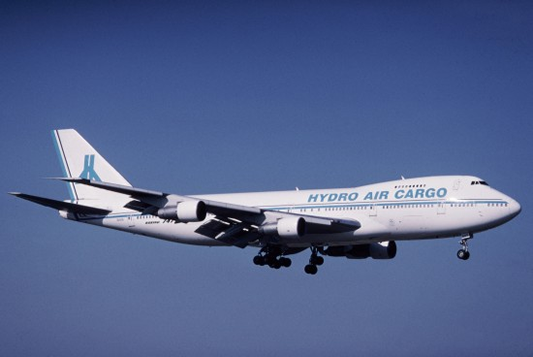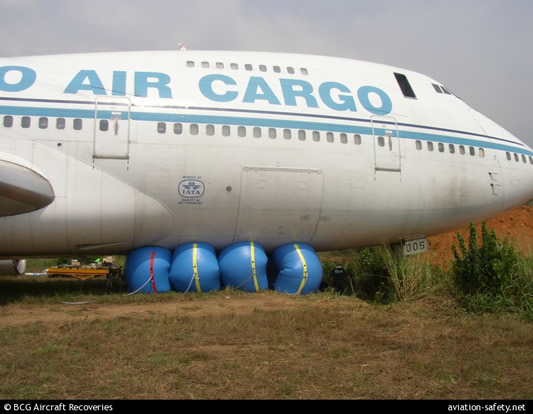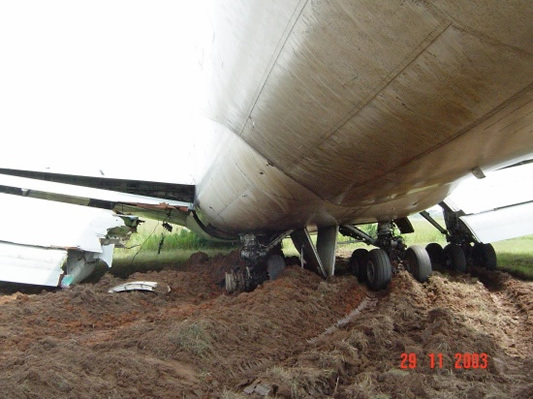|
|
Twee keer is scheepsrecht
Lagos is de grootste stad in Nigeria. Gevoelsmatig bedeel je de stad dan ook de titel van hoofstad van Nigeria toe maar dat is niet correct. De officiele hoofstad van het land is het centraal gelegen Abuja. Toch is Lagos in veel opzichten , economisch en in aantal inwoners, de belangrijkste stad. Het is een smeltkroes van alle stammen die Nigeria bevolken en chaos is er troef. Het verkeer door de stad staat vaak in lange files die maar moeizaam oplossen. Het moeizame doorstromen van het autoverkeer lijkt ook wel gekopieerd te worden in de regeling van het luchtverkeer.
Air Traffic Control ( ATC of Luchtverkeersleiding ) in geheel Nigeria heeft lange tijd als onbetrouwbaar te boek gestaan. Zodra je gaat landen op een luchthaven in Nigeria moet je op je hoede zijn. Het maakt niet uit of dat in Lagos is of Kano, Abuja of Port Harcourt. Vluchten naar deze bestemmingen leveren altijd problemen op met de weersomstandigheden, de navigatiehulpmiddelen, de lokale luchtvaartmaatschappijen en natuurlijk ATC. In april 2001 vond er een ernstig incident plaats tijdens de nadering naar het vliegveld Murtalla Mohammed van Lagos. Het betrokken vliegtuig was een B767 en de copiloot schreef naderhand het volgende verslag.
Welcome to Lagos!
 This was going to be my first flight to Lagos Airport on the B767. To prepare for this airport I viewed the Route Clearance Unit briefing and also the fly-away pamphlet was studied carefully. This was going to be my first flight to Lagos Airport on the B767. To prepare for this airport I viewed the Route Clearance Unit briefing and also the fly-away pamphlet was studied carefully.
Lagos Airport consists of two parallel runways, 19L and 19R, both equipped with an ILS. 19R is the main landing runway, which was stressed in the briefings as well. For our flight no special NOTAMS were applicable.
The captain had been flying to Lagos on another aircraft type before, and did not visit Lagos recently. He offered me to be Pilot Flying. When in VHF contact with Lagos Approach the actual weather was received. Wind 180° at 10 knots, NIL weather, temperature 29 degrees Centigrade. The Air Traffic Controller spoke very unclearly and rapidly. He had to repeat the weather three times. The approach was executed during darkness. We approached from the North, with a South African Airways B747 approaching from the South at the same time. Descent clearance was received and an ILS approach for runway 19R was offered. The SAA B747 was told to expect 19R as well.
The Controller used a lot of non-standard R/T phraseology and both the SAA and our flight had to ask again and again to repeat the clearances. As the weather was very stable, with excellent visibility and no turbulence, it was decided to fly the approach manually. We were cleared down to 2200 feet and cleared for approach runway 19R as well. From a far distant we clearly saw the runways as on both of them the runway lights were switched on. Upon intercept we only received the glideslope but no localiser. Upon reporting this, we were recleared on a visual approach. No reason for concern,after all this was Africa. As the approach lights were too bright and it was pitch-dark, we asked to dim the lights. For that request we had to contact the Tower. The Tower Controller cleared us to land on 19R.
He also spoke very unclearly and rapidly. At 500 feet above the ground he began an incomprehensible monologue. We could distinguish the words 19 Left and therefore thought he asked us to side step towards runway 19L. As this was impossible because of our low altitude we continued for 19R. The Controller continued shouting at us while we once more asked him if he wanted us to execute a go-around. Finally we felt too uncomfortable to continue. About 100 feet above the ground we made a go-around.
The Missed Approach Procedure calls for a right turn in a North Easterly direction direct to the LAG VOR, located a few miles in front of 19L at 2200 feet. The Tower Controller asked us to report on left-hand downwind, but we refused this and turned right on a Northerly heading since the SAA B747 was flying East of the field inbound the LAG VOR, descending to 2200 feet as well. He then cleared us directly to the VOR, but we refused that again because the SAA B747 was approaching the holding there at 2200 feet.So insufficient separation would be next. The B747 saw us on TCAS in the go-around and after co-ordination they descended to 3500 feet instead to allow us room for an ILS approach on runway 19L. We landed there safely.
At the airport we asked for the transcripts of our conversation with Lagos ATC. We also visited the SAA crew. They heard the same as we did: cleared approach 19Right. They were given the same clearance as well. It took away our concern that we might had misunderstood the Controller. The transcript revealed that when we asked to dim the approach and runway lights, somebody mentioned : “19 Right closed”.
I cannot withhold you this particular part of the transcript; the text between brackets was incomprehensible.
Tower |
[ correcting KLM 587 runway in use 19 Left, 19 Left , 19 Left in use ] |
Aircraft |
KLM 587. say again please |
Tower |
KLM 587, 19 Left in use 19 Left in use |
Aircraft |
KLM 587. we are too low for 19 Left. We are passing 500 feet for 19 Right.
What do you want us to do? Do we make a go-around? |
Tower |
[It is better you make a go-around because there is construction work going on 19R, construction work going on 19R] |
Aircraft |
Okay, we are 300 feet for 19 Right what do you want us to do now? Do we land or make a go-around? |
Tower
|
I say again make a go-around, make a go-around [there is a construction work on 19R] |
Aircraft |
KLM 587 going around |
Please bear in mind that the controller did not speak utterly Oxford English,..
Only after the go-around, when we specifically asked for the reason, the Tower Controller started talking like a runaway freight train whereupon we finally understood that the runway was closed due to maintenance. We did not see any vehicles or anything which could
indicate work in progress. Because all lights were on and part of the ILS was working, it was the main landing runway. Both Approach and Tower had cleared us for this runway and initially we were absolutely convinced that we were supposed to land on 19R. Work in progress can indicate changing light bulbs, doesn't it?
However a few weeks later we discovered the real truth:
There were holes in the runway of 20 metres by 3 metres. 50 centimetres deep...
A little angel had been jump-seating with us.
And welcome again..
Narrative:
Hydro Air Cargo's Boeing 747 freighter ZS-OOS was operating on a cargo flight from Brussels (BRU) to Johannesburg (JNB) with an intermediate stop at Lagos (LOS). A Notam stated that runway 19R, a 3900 x 60 meters asphalt runway, was closed because of resurfacing work. During the descent the controller at Lagos told the crew that 19R was in use. After a query by the Hydro crew he made the correction and reported that the runway in use was 19L. Apparently the approach controller cleared the flight to land on 19R. On landing the Boeing struck stacks of asphalt and the aircraft slewed left with its first engine in contact with the surface until the nose wheel came to rest in a drainage ditch.
The AIPB reported that the Nigerian Civil Aviation Authority did not know of the closure of the runway, nor that it was aware of the NOTAM until the accident occurred. Runway 19R was not properly closed in accordance with standard practice, as the runway lights were all switched on indicating runway serviceability.
When the Nigeria Ministry of Aviation published its final report last year on an accident involving a South African Hydro Air Boeing 747 freighter damaged by landing at Lagos in November 2003, it paints a picture of carelessness that appears to be endemic at all levels. The report says that the Lagos area controller, when first contacted by the aircraft – callsign Hydro Cargo 501 – at a range of 280km (150nm) “absentmindedly passed the airfield information to the aircraft [saying] that the runway in use was 19R”. The flightcrew, having seen a notice to airmen (NOTAM) saying that 19R was out of use because of resurfacing work, requested confirmation. The area controller knew about the work in progress, says the report, which explained that when Hydro 501 queried the runway in use “he became conscious and made the correction that the runway in use was 19L.” The pilot called again: “Ah, you gave us 19R, is 19R available?” The area controller replied: “Negative, correction, it’s 19L. You verify with approach control.”
That night, according to the report, the approach and tower tasks were being carried out by a single controller. When area control told Hydro 501 to contact Lagos tower, the first mention of the runway was in the tower’s message: “501 continue the descent to 3,500ft [1.070m], QNH one zero, no delay for ILS approach to one niner right...report passing [flight level] 150”. Hydro replied: “We’ll call you passing 150 for 3,500ft and confirm we, uh, can land runway one niner right?” to which the tower response was “Affirm, cleared for ILS one niner right”.
During the landing on runway 19R, on which there were stacks of asphalt and gashes in the surface, the report says that the aircraft’s left main wing gear was ripped off, the centre main gear was severely damaged, and the aircraft slewed left with its No 1 engine in contact with the surface until the nosewheel came to rest in a drainage ditch. Tower called: “Hydro Cargo 501, your position?” The 747’s flightcrew replied: “You cleared us to land on a runway that was closed.”
The Ministry of Aviation report concluded that the cause of the accident was that the aircraft was cleared to land on a runway that was “supposed” to have been closed. Contributory factors were that the runway was “not properly closed in accordance with standard practice, the runway edge lights-– were all switched on indicating runway serviceability”. Also cited was an incomplete handover briefing between the controllers going off duty and those taking over for the watch during which the Hydro 501 approach took place. The report notes that “the Nigerian Civil Aviation Authority did not know of the closure of the runway...nor was it aware of the NOTAM until the accident had occurred”.




foto's © BCG Aircraft Recoveries
Deze pagina is voor het laatst bijgewerkt op
11-06-2024
|


